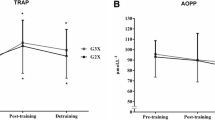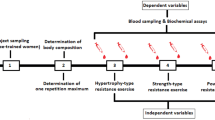Abstract
Purpose
The aim of this study was to evaluate whether a resistance training (at least 6 months of practice) would be beneficial in improving trained subjects’ response to oxidative stress.
Methods
The study evaluated 19 volunteers aged between 18 and 32 years, who were divided into two groups: sedentary and trained. In order to induce an oxidative stress condition, all individuals participated in a single intense-strength session. Volunteers’ blood was collected before and after the exercise practice, which was used later on for biochemical analyses (TBARS, uric acid and activity of superoxide dismutase and catalase). Furthermore, physical fitness of the participants was evaluated through high-yield tests (strength, agility and aerobic endurance).
Results
We found that all measured physical fitness variables were superior in the trained subjects. Additionally, sedentary individuals presented higher levels of plasma malondialdehyde after the intense exercise session (157 % higher; 1.9 ± 1.1–4.9 ± 3.1). No difference was found in uric acid concentration between groups. An increase of SOD activity (50 % greater; 0.4 ± 0.19–0.6 ± 0.12) was also demonstrated in the erythrocytes of sedentary subjects after the exercise practice. SOD activity did not change in the trained group. On the contrary, CAT activity increased only in the trained subjects (48.2 % greater; 2.7 ± 0.9–4.2 ± 1.2).
Conclusion
Resistance training was effective in increasing participants’ physical fitness, and also in improving their response to the oxidative stress induced by an intense exercise practice. This mechanism may help trained subjects to improve their performance and health.




Similar content being viewed by others
Abbreviations
- BHT:
-
t-Butyl hydroperoxide
- BMI:
-
Body mass index
- CAT:
-
Catalase
- GPx:
-
Glutathione peroxidase
- LLS:
-
Lower limb strength
- MDA:
-
Malondialdehyde
- RM:
-
Repetition maximum
- ROS:
-
Reactive oxygen species
- SOD:
-
Superoxide dismutase
- TBARS:
-
Thiobarbituric acid reactive substances
- ULS:
-
Upper limb strength
References
Barbieri E, Sestili P (2012) Reactive oxygen species in skeletal muscle signaling. J Signal Transduct 2012:982794. doi:10.1155/2012/982794
Sies H (1985) Oxidative stress: introductory remarks. In: Sies H (ed) Oxidative stress. Academic Press, London, pp 1–7. ISBN 978-0-12-642760-8
Brieger K, Schiavone S, Miller FJ Jr, Krause KH (2012) Reactive oxygen species: from health to disease. Swiss Med Wkl 142:w13659. doi:10.4414/smw.2012.13659
Farhat F, Dupas J, Amerand A, Goanvec C, Feray A, Simon B, Guegueniat N, Moisan C (2015) Effect of exercise training on oxidative stress and mitochondrial function in rat heart and gastrocnemius muscle. Redox Rep: Commun Free Radic Res 20(2):60–68. doi:10.1179/1351000214Y.0000000105
Halliwell B (2006) Reactive species and antioxidants. Redox biology is a fundamental theme of aerobic life. Plant Physiol 141(2):312–322. doi:10.1104/pp.106.077073
Halliwell B, Gutteridge J (2007) Free radicals in biology and medicine. Oxford University Press, Oxford
Hernandez A, Cheng A, Westerblad H (2012) Antioxidants and skeletal muscle performance: “common knowledge” vs. experimental evidence. Front Physiol 3:46. doi:10.3389/fphys.2012.00046
Anderssen SA, Carroll S, Urdal P, Holme I (2007) Combined diet and exercise intervention reverses the metabolic syndrome in middle-aged males: results from the Oslo Diet and Exercise Study. Scand J Med Sci Sports 17(6):687–695. doi:10.1111/j.1600-0838.2006.00631.x
Albright A, Franz M, Hornsby G, Kriska A, Marrero D, Ullrich I, Verity LS (2000) American College of Sports Medicine position stand. Exercise and type 2 diabetes. Med Sci Sports Exerc 32(7):1345–1360
Heath GW, Hagberg JM, Ehsani AA, Holloszy JO (1981) A physiological comparison of young and older endurance athletes. J Appl Physiol: Respir Environ Exerc Physiol 51(3):634–640
Selamoglu S, Turgay F, Kayatekin BM, Gonenc S, Yslegen C (2000) Aerobic and anaerobic training effects on the antioxidant enzymes of the blood. Acta Physiol Hung 87(3):267–273. doi:10.1556/APhysiol.87.2000.3.5
Barker AR, Breese BC, Willcocks RJ, Williams CA (1985) Armstrong N (2010) Commentaries on Viewpoint: do oxidative and anaerobic energy production in exercising muscle change throughout growth and maturation? The importance of exercise intensity when studying developmental energy metabolism. J Appl Physiol 109(5):1565–1566
Winett RA, Carpinelli RN (2001) Potential health-related benefits of resistance training. Prev Med 33(5):503–513. doi:10.1006/pmed.2001.0909
Jenkins RR (2000) Exercise and oxidative stress methodology: a critique. Am J Clin Nutr 72(2 Suppl):670S–674S
Krause M, Rodrigues-Krause J, O’Hagan C, Medlow P, Davison G, Susta D, Boreham C, Newsholme P, O’Donnell M, Murphy C, De Vito G (2014) The effects of aerobic exercise training at two different intensities in obesity and type 2 diabetes: implications for oxidative stress, low-grade inflammation and nitric oxide production. Eur J Appl Physiol 114(2):251–260. doi:10.1007/s00421-013-2769-6
Shi M, Wang X, Yamanaka T, Ogita F, Nakatani K, Takeuchi T (2007) Effects of anaerobic exercise and aerobic exercise on biomarkers of oxidative stress. Environ Health Prev Med 12(5):202–208. doi:10.1265/ehpm.12.202
Awobajo FO, Olawale OA, Bassey S (2013) Changes in blood glucose, lipid profile and antioxidant activities in trained and untrained adult male subjects during programmed exercise on the treadmill. Niger Quart J Hosp Med 23(2):117–124
Rosety-Rodriguez M, Rosety I, Fornieles-Gonzalez G, Diaz-Ordonez AJ, Camacho A, Rosety MA, Pardo A, Rosety M, Alvero R, Ordonez FJ (2012) A 6-week training program increased muscle antioxidant system in elderly diabetic fatty rats. Med Sci Monit: Int Med J Exp Clin Res 18(9):BR346–BR350
Karvonen MJ, Rautaharju P, Rikkonen P, Ruosteenoja R (1957) Heart size of champion skiers. Annales medicinae internae Fenniae 46(4):169–178
American College of Sports Medicine (2003) ACSM’s resource manual for guidelines for exercise testing and prescription, 4th edn. Lippincott Williams & Wilkins, Philadelphia. ISBN 9780781725255
Mann JB, Stoner JD, Mayhew JL (2012) NFL-225 test to predict 1RM bench press in NCAA Division I football players. J Strength Cond Res/Natl Strength Cond Assoc 26(10):2623–2631. doi:10.1519/JSC.0b013e31826791ef
Sayers SP, Harackiewicz DV, Harman EA, Frykman PN, Rosenstein MT (1999) Cross-validation of three jump power equations. Med Sci Sports Exerc 31(4):572–577
Little T, Williams AG (2005) Specificity of acceleration, maximum speed, and agility in professional soccer players. J Strength Cond Res/Natl Strength Cond Assoc 19(1):76–78. doi:10.1519/14253.1
Weltman J, Seip R, Levine S, Snead D, Rogol A, Weltman A (1989) Prediction of lactate threshold and fixed blood lactate concentrations from 3200-m time trial running performance in untrained females. Int J Sports Med 10(3):207–211. doi:10.1055/s-2007-1024902
Gordon NF, Kohl HW 3rd, Pollock ML, Vaandrager H, Gibbons LW, Blair SN (1995) Cardiovascular safety of maximal strength testing in healthy adults. Am J Cardiol 76(11):851–853
Borg GA (1982) Psychophysical bases of perceived exertion. Med Sci Sports Exerc 14(5):377–381
Flohe L, Otting F (1984) Superoxide dismutase assays. Methods Enzymol 105:93–104
Aebi H (1984) Catalase in vitro., vol 105
Bradford MM (1976) A rapid and sensitive method for the quantitation of microgram quantities of protein utilizing the principle of protein-dye binding. Anal Biochem 72:248–254
Janero DR (1990) Malondialdehyde and thiobarbituric acid-reactivity as diagnostic indices of lipid peroxidation and peroxidative tissue injury. Free Radic Biol Med 9(6):515–540
Fossati P, Prencipe L, Berti G (1980) Use of 3,5-dichloro-2-hydroxybenzenesulfonic acid/4-aminophenazone chromogenic system in direct enzymic assay of uric acid in serum and urine. Clin Chem 26(2):227–231
Theodosiou K, Bogdanis GC, Gkantiraga E, Gissis I, Sambanis M, Souglis A, Sotiropoulos A, Papadopoulos C (2014) Multiarticular isokinetic high load eccentric training induces large increases in eccentric and concentric strength and jumping performance. J Strength Cond Res/Natl Strength Cond Assoc. doi:10.1519/JSC.0000000000000456
Crewther BT, Heke TL, Keogh JW (2013) The effects of a resistance-training program on strength, body composition and baseline hormones in male athletes training concurrently for rugby union 7’s. J Sports Med Phys Fit 53(1):34–41
Bell GJ, Petersen SR, Wessel J, Bagnall K, Quinney HA (1991) Adaptations to endurance and low velocity resistance training performed in a sequence. Can J Sport Sci = Journal canadien des sciences du sport 16(3):186–192
Nordsborg NB, Lundby C, Leick L, Pilegaard H (2010) Relative workload determines exercise-induced increases in PGC-1alpha mRNA. Med Sci Sports Exerc 42(8):1477–1484. doi:10.1249/MSS.0b013e3181d2d21c
Mahattanatawee K, Manthey JA, Luzio G, Talcott ST, Goodner K, Baldwin EA (2006) Total antioxidant activity and fiber content of select Florida-grown tropical fruits. J Agric Food Chem 54(19):7355–7363. doi:10.1021/jf060566s
Stahl WAO, Sies H, Polidori MC (2001) Analysis of lipophilic antioxidants in human serum and tissues: tocopherols and carotenoids. J Chromatogr 936:983–993
Barreiros Albsd JM, David JP (2006) Oxidative stress: relation between reactive species generation and organism defense New Quimic 29(1):113–123
Kabasakalis A, Tsalis G, Zafrana E, Loupos D, Mougios V (2014) Effects of endurance and high-intensity swimming exercise on the redox status of adolescent male and female swimmers. J Sports Sci 32(8):747–756. doi:10.1080/02640414.2013.850595
Pryor WA, Houk KN, Foote CS, Fukuto JM, Ignarro LJ, Squadrito GL, Davies KJ (2006) Free radical biology and medicine: it’s a gas, man! Am J Physiol Regul Integr Comp Physiol 291(3):R491–R511. doi:10.1152/ajpregu.00614.2005
Xu X, Thompson LV, Navratil M, Arriaga EA (2010) Analysis of superoxide production in single skeletal muscle fibers. Anal Chem 82(11):4570–4576. doi:10.1021/ac100577q
Comhair SA, Erzurum SC (2002) Antioxidant responses to oxidant-mediated lung diseases. Am J Physiol Lung Cell Mol Physiol 283(2):L246–L255. doi:10.1152/ajplung.00491.2001
Valko M, Leibfritz D, Moncol J, Cronin MT, Mazur M, Telser J (2007) Free radicals and antioxidants in normal physiological functions and human disease. Int J Biochem Cell Biol 39(1):44–84. doi:10.1016/j.biocel.2006.07.001
Zembron-Lacny A, Ostapiuk J, Slowinska-Lisowska M, Witkowski K, Szyszka K (2008) Pro-antioxidant ratio in healthy men exposed to muscle-damaging resistance exercise. J Physiol Biochem 64(1):27–35
Ji LL, Kang C, Zhang Y (2016) Exercise-induced hormesis and skeletal muscle health. Free Radic Biol Med. doi:10.1016/j.freeradbiomed.2016.02.025
Ji LL (2015) Redox signaling in skeletal muscle: role of aging and exercise. Adv Physiol Educ 39(4):352–359. doi:10.1152/advan.00106.2014
Acknowledgments
Coordenação de Aperfeiçoamento de Pessoal de Nível Superior (CAPES), Fundação de Amparo à Pesquisa do Estado de São Paulo (FAPESP), Conselho Nacional de Desenvolvimento Científico e Tecnológico (CNPq) are acknowledged.
Author information
Authors and Affiliations
Corresponding author
Ethics declarations
Conflict of interest
We declare that we have no conflict of interest.
Ethical approval
Ethics Committee of the Cruzeiro do Sul University approved the study (Protocol: CE/UCS-063/2013).
Informed consent
All participants were informed about the details of the study and signed the informed consent form.
Rights and permissions
About this article
Cite this article
da Silva, E.P., Oliveira Soares, E., Malvestiti, R. et al. Resistance training induces protective adaptation from the oxidative stress induced by an intense-strength session. Sport Sci Health 12, 321–328 (2016). https://doi.org/10.1007/s11332-016-0291-z
Received:
Accepted:
Published:
Issue Date:
DOI: https://doi.org/10.1007/s11332-016-0291-z




